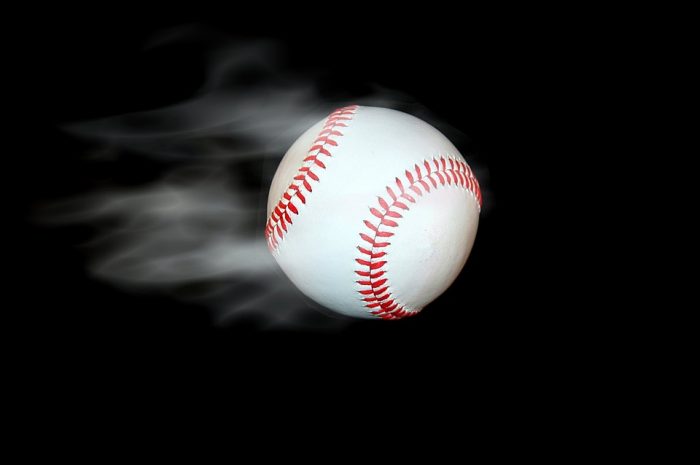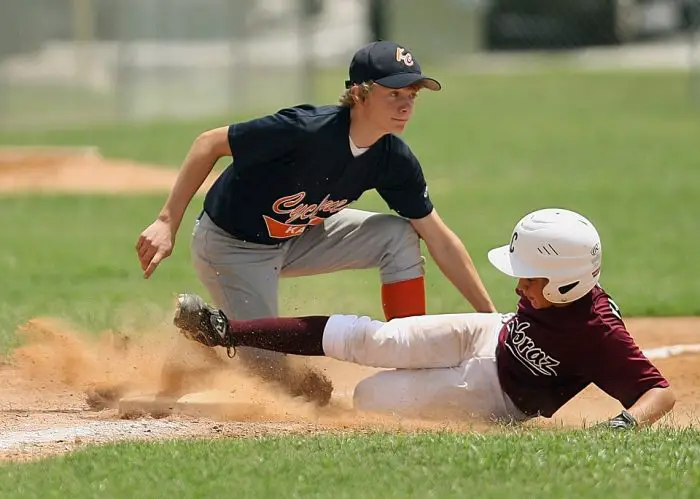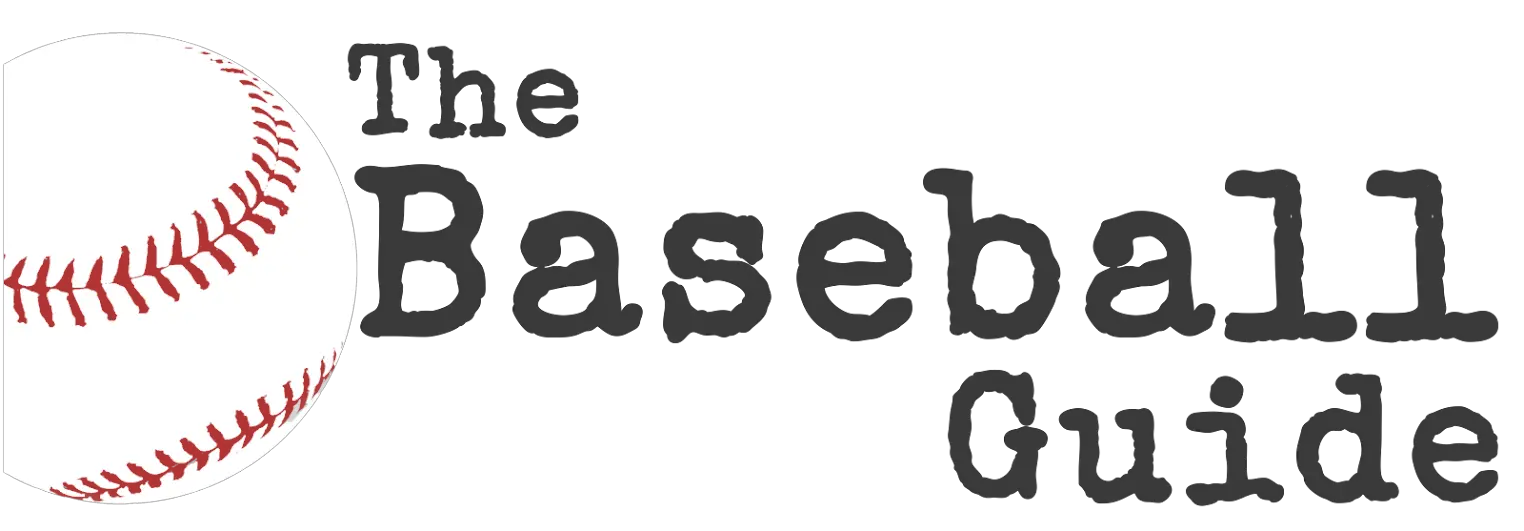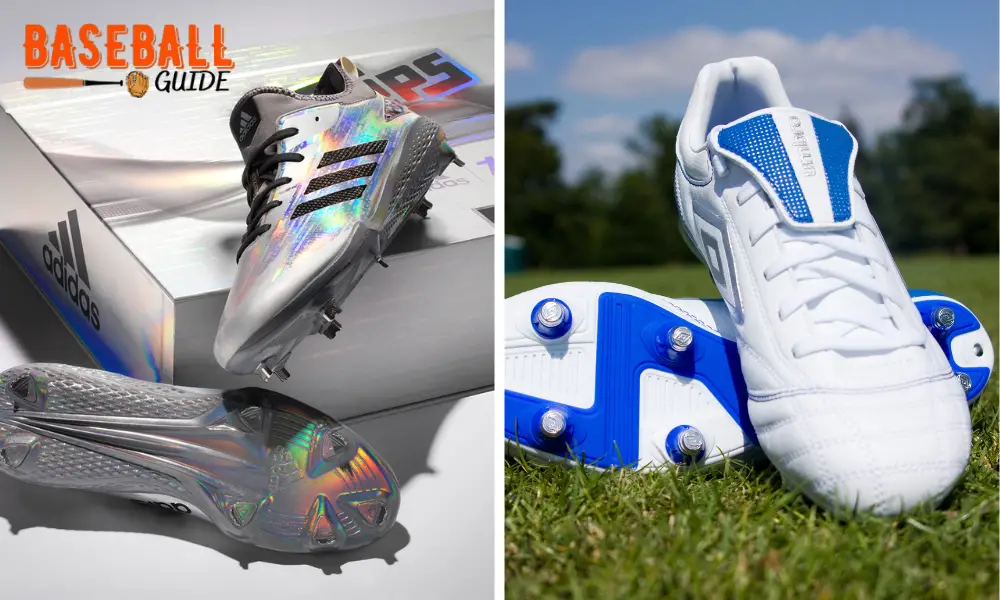The assumption that many people make is that baseball and football cleats are the same because they both look similar upfront. However, this is not the case.
While they both give athletes the traction needed for optimal performance on the field, football, and baseball cleats have their specific properties and serve a distinct purpose for the players.
In this article, let’s analyze the key characteristics of football and baseball cleats to see how they differ from each other.
Comparison Between Football Cleats & Baseball Cleats
| Feature | Football Cleats | Baseball Cleats |
|---|---|---|
| Size | Larger | Smaller |
| Cleat Type | Molded or detachable | Molded |
| Cleat Length | Longer | Shorter |
| Material | Synthetic or leather | Leather |
| Ankle Support | High | Low |
| Comfort | Padded insole | Cushioned |
| Traction | Designed for grass, turf or mud | Designed for dirt or grass |
| Position-specific | Yes | No |
| Usage Frequency | High | High |
| Brand Options | Many | Many |
| Price | Varies | Varies |
Can You Use Baseball Cleats for Football?

Simply put, you can’t play football using your baseball cleats.
Baseball cleats are lighter which can be detrimental if you play football due to the sport’s involvement of rough physical contact and banging causing your feet to suffer throughout the game.
It’s also not safe for you and other players if you wear baseball cleats because of their stud configuration. The razor-like studs and the extra toe stud on the front of baseball cleats can be very dangerous on the field.
You will also not get enough foot and ankle support and protection if you choose to wear baseball cleats when playing football.
Although both cleats look the same, they are poles apart from each other so it’s best to put your baseball cleats off the football field.
Can You Use Football Cleats for Baseball?
Technically, you can. However, football cleats are not ideal when playing baseball.
Granting that they both offer traction on the field, the cleat pattern of baseball cleats is more consistent thus offering more accurate grip and more stability which is needed for the sport.
Football cleats are also more on the heavier and rigid side. This can cause fatigue and discomfort on your feet a lot quicker than you do with appropriate baseball cleats thus affecting your performance.
Since playing baseball involves plenty of forwarding motion and quick acceleration, heavy football cleats can also slow you down.
You should know the importance of wearing baseball cleats. It’s often best to make sure your cleats are lightweight so that you can pick up speed and quickly change direction.
Difference between Baseball and Football Cleats
Cleats Pattern
Baseball and football cleats have different patterns that are specifically designed to create traction and help players get a grip on the field in their specific sport.
Football cleats possess rounder and larger studs typically made of plastic or rubber. This allows football players to maintain their footing on artificial grass and increases mobility during play.
When it comes to the number of studs, football cleats contain more studs than baseball cleats which can range anywhere from seven to 14 studs on each outsole.
Most of the studs are also focused on the front area of the cleats, along the sides, and a few more on the heels.
The length of the studs on football cleats is also very different since they feature much longer and have a varying range of length to help players gain better traction on the grass or artificial turf depending on their position.
On the other hand, baseball cleats feature more pointed and sharper studs designed to dig into the dirt or grass easier.
They give players a quick first step which is crucial during situations where they need a jolt of acceleration.
Baseball cleats are also available in a wider selection from metal cleats, molded or TPU cleats, and turf shoes that football cleats don’t have.
They also have shorter patterns and more consistent stud lengths along the outsole to help players keep their balance and get a quicker start.
Weight of Cleats
Football cleats are generally thicker, more supportive, and heavier in comparison to baseball cleats. Baseball cleats are lightweight as compared to football cleats.
They also tend to be made of thicker materials and rigid construction which add to the weight of the cleats but are purposely designed so to maximize protection rather than comfort since football is a rigorous sport.
They are constructed to be tough and hand a lot of support to help absorb impacts from your feet landing after every move.
Meanwhile, baseball cleats are designed for faster movement and flexibility.
Their lightweight design gives players greater control over their movements, allowing them to move around the field swiftly and efficiently.
Ankle Support
Generally speaking, football cleats offer more ankle support than baseball cleats do.
Although both cleats come in low-tops, mid-tops, and high-tops cut designs, you will see more football players sporting high-top cleats on the field than you do with baseball players.
This is due to the positional differences and requirements of the football players.
There are other players, such as those who play the offense like linemen, who require more ankle support than the other positions who might require less ankle support but more agility and mobility on the field.

Whereas, baseball players, regardless of their position, don’t require as much ankle support as football players do.
Some baseball players do wear cleats with mid-top cuts at their preference or discretion only but it’s rare to see high-top cleats on the baseball field.
Front Area of Cleats
Football and baseball cleats provide protection over various playing surfaces. Both cleats feature toe guards for added durability and protection needed by both players.
A major difference between the two cleats is the added toe stud on baseball cleats, which allows for better traction on the balls of the feet.
This allows baseball players to easily make a sharp cut and dig easily on the ground.
Football cleats do not have this feature for safety reasons. This poses a danger to other players since there are frequent occurrences of tackles on football fields.
Comfort
In general, football cleats are less comfortable to wear compared to baseball cleats.
Football cleats tend to be thicker, heavier, tougher, and less flexible than baseball cleats due to the weight-bearing requirement and collision nature of the sport.
They also have less midsole padding and less cushioning but with more rigid sidewalls that all contribute to the overall support of the cleats.
On the other hand, baseball cleats are designed with a comfortable feel in mind.
They provide a little more cushioning and more mid-foot support with a more flexible construction. Baseball cleats are also less restrictive, allowing for more speed and flexibility that players require on the field.
FAQs About Football and Baseball Cleats
-
Can you use baseball cleats for football?
No, baseball cleats cannot be used for football as they are lighter and lack the necessary support and protection required for the sport. The stud configuration of baseball cleats, especially the razor-like studs and extra toe studs, can also be dangerous on the football field.
-
Can you use football cleats for baseball?
Technically, football cleats can be used for baseball, but they are not ideal as they are heavier and more rigid than baseball cleats. Baseball cleats are designed to be lightweight for faster movement and flexibility, and their cleat pattern is more consistent and accurate for better grip and stability.
-
How do the cleat patterns of baseball and football cleats differ?
Football cleats have rounder and larger studs made of plastic or rubber to maintain footing on artificial grass and increase mobility. The studs are focused on the front area of the cleats, along the sides, and a few on the heels. The studs on football cleats are also longer and have varying lengths to help players gain better traction. Baseball cleats feature more pointed and sharper studs designed to dig into the dirt or grass easier. The studs are more consistent in length along the outsole and are available in a wider selection of metal, molded or TPU cleats, and turf shoes.
-
How do baseball and football cleats differ in weight?
Football cleats are generally thicker, more supportive, and heavier in comparison to baseball cleats, which are lightweight for faster movement and flexibility. Football cleats are designed to be tough and offer maximum protection rather than comfort since football is a rigorous sport.
-
How do baseball and football cleats differ in ankle support?
Football cleats offer more ankle support than baseball cleats, as they are designed to cater to the positional differences and requirements of football players. Football players, particularly those who play the offense like linemen, require more ankle support than baseball players. Baseball players, regardless of their position, don’t require as much ankle support as football players do.
Final Words
Wearing the right cleats can cause your performance to improve in any sport. Therefore, it is important to wear the specified ones, especially during big leagues.
As can be seen above, football and baseball cleats are very different. We have also done a good comparison of baseball and soccer cleats, you can check that article.
Although they do the same job of protecting your feet and providing traction, there are still many differences that any athlete should consider before deciding what type of cleat to wear for their specific sport.

